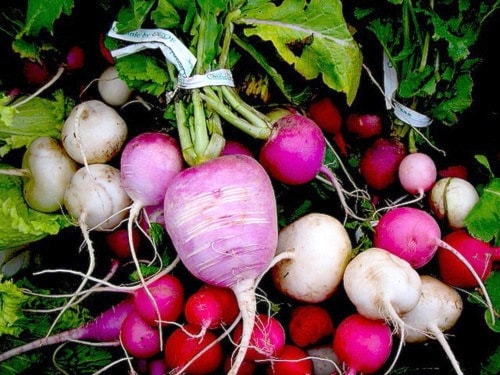Finally, it’s time to get your early vegetables growing if you want to savour the wonderful fresh taste of new vegetables this spring. Keep in mind, however, not all vegetables can be started early. Many, like bush and pole beans, need warmer soil temperatures for good germination and successful growth. At this time of year, you should be using raised beds of eight to 10 inches, and it is essential to have good soil preparation and drainage.
Even though many seed catalogues recommend a later start, broad beans can be planted now. These large beans love cooler soil temperatures and mature early in the spring before the weather becomes too warm. If you haven’t tried them before, plant a few this year – they’re delicious.
Early brassicas (cabbage, cauliflower, broccoli and kale), can be underway now as well. They do best from seedlings started indoors, but it’s important to use only early varieties at this time of year as they are bred to withstand cool conditions and to mature in early spring weather. Brassicas are lime lovers so use plenty of Dolopril lime in the rows. If root maggots have been a problem in the past, try adding fir or hemlock bark mulch and sand to improve the openness and porosity of the soil.
Lettuce is possibly the oldest, most popular of all vegetables. It will grow under a wide diversity of conditions, but prefers cool growing temperatures of between 50 and 60 degrees Fahrenheit. You can seed it directly in the ground later on, but for early crops, it’s best to transplant seedlings.
 Leaf lettuce is faster maturing than head types. Try some of the new loose head varieties like Buttercrunc’ and for an interesting change, plant some of the new vibrant red-leafed varieties – they really colour up both the garden and a salad bowl. The red romaine, mesclun salad blends and other interesting lettuce mixes will really spice up your taste buds too. A newer must-try are the Simply Salad lettuce blends. I think they are fabulous both for looks and flavour. Lettuce plants love high-nitrogen soil, so mix plenty of compost and manures in their planting area.
Leaf lettuce is faster maturing than head types. Try some of the new loose head varieties like Buttercrunc’ and for an interesting change, plant some of the new vibrant red-leafed varieties – they really colour up both the garden and a salad bowl. The red romaine, mesclun salad blends and other interesting lettuce mixes will really spice up your taste buds too. A newer must-try are the Simply Salad lettuce blends. I think they are fabulous both for looks and flavour. Lettuce plants love high-nitrogen soil, so mix plenty of compost and manures in their planting area.
Sweet Spanish onions won’t be as sweet unless they are in the ground soon. You can seed them directly, but I prefer transplants to save both thinning and time. Many varieties are now available, but remember: Some are good keepers while others are not. You may also want to try Kelsae Giant, the world’s largest onion – they are quite something! They all prefer a light, sandy loam and the hottest spot in the garden.
In mild climates, bunching onions can be grown almost year round. Varieties like the white Lisbon, Tokyo, Long White and Stay Green Bunching are all excellent varieties. Many gardeners still prefer to use multiplier onion bulbs for some quick greens. I know one lady who plants multipliers in her garden every six weeks year round.
Peas are cool croppers as well. It’s a great idea to sow just a few every two weeks until mid-May. Peas prefer a light, loamy soil, and I think you’ll find fewer disease and insect problems if you take the time to keep your soil on the light side. Soil inoculants are a great idea for peas. All you do is sprinkle the dry granules of these live nitrogen-fixing bacteria over the seed before you cover them up. You should find both improved growth and increased yields. By the way, many new varieties of Sugar Snap peas are the sweetest, most tender peas that I’ve ever tasted.
Radishes, too, can be planted now. They need a well-mulched soil that has very good drainage. If the soil stays too wet, the radishes will split. On the other hand, they need moisture too. If we don’t get lots of rain, water them to prevent them from becoming woody or pithy. There’s nothing worse than a pithy radish. To avoid maggot problems, try raking wood ashes into the seed rows, and never grow radishes where brassicas were grown the previous year.
Spinach is another good cold crop. Believe it or not, spinach germinates best at 40 degrees Fahrenheit, so it should be quite happy to go in the ground soon. If you would like to enjoy spinach all season, even during the heat of summer, try the perennial variety New Zealand. Its seeds are nut-like in flavour and slow to germinate. The most awesome spinach, however, is Red Malabar Climbing Spinach. It grows like a vine and has beautiful purplish foliage, blue flowers and sweet tender leaves all summer. Malabar, however, needs heat and cannot go in until the end of May like most warmth-loving vegetables.
If you’d like a head start on other vegetables, such as early potatoes and swiss chard, choose the warmest spot in your garden, make sure the soil is well drained and use raised beds. We can still get some pretty good frosts, so please make sure you have protective coverings like the new N-Sulate cloth that can make an 8°C difference in temperature or traditional cloches.
Brian Minter is a master gardener who operates Minter Gardens in Chilliwack.
